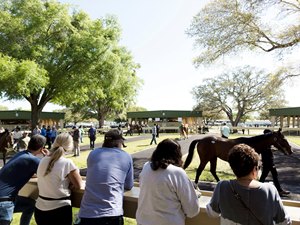Higher Yearling Costs to Trim Margins for 2YO Pinhooks


A continuation of near-record purses at United States racetracks is expected to keep business at this year's 2-year-olds in training market as robust as it's been for the past two years. But even with a stable market, pinhookers are facing a significant drop in overall profitability because the horses they will be selling are more expensive.
Juvenile sales have collectively enjoyed an unprecedented three-year run with averages for 2021-23 all well above $90,000. The market hit a peak in 2022 when 2,297 horses averaged $97,093 and last year generated a record $227.6 million in gross sales.
The growth in purses has contributed to these strong results, with total available U.S. purses rising nearly 11% from 2021 to 2022 and holding steady above $1.3 billion for 2022 and 2023.
As the 2-year-olds in training market has grown, however, so in turn has the yearling market. The Keeneland September Yearling Sale set records in 2022 for gross ($418,271,200) and average ($141,165) and was close to those marks in 2023 (gross of $408,179,900 and $141,484 average). The overall North American yearling average also has been north of $94,000—$94,849 in 2022 and $94,441 in 2023.
Consequently, the average price of pinhooked yearlings has gone up. The average yearling price of horses cataloged for the Ocala Breeders' Sales March 2-Year-Olds in Training Sale is $83,089, according to figures compiled by BloodHorse, which is up 15% from last year's equivalent average of $72,244. These averages include only horses bought at yearling sales and does not include winter mixed or fall mixed sales.

"It is hard to know what to expect. I think we have a really good bunch going in (the March sale), they are a lovely bunch of horses at the end of a shank and are training as good as we could hope going in. Then I look at what we paid for them," said Ciaran Dunne with Wavertree Stables. "Yearlings were very expensive and very hard to buy. At the level of what we paid for them, there is not much room for a slip-up; everything has to go right to get rewarded."
David O'Farrell, with Ocala Stud and an OBS board member, said the 1,200 horses cataloged for the OBS Spring 2-Year-Olds in Training Sale also have a yearling average around $81,000.
"That's really unbelievable," he said. "For an $81,000 pinhook, you need to get around $120,000 to about break even. That is pretty risky business. And, $80,000 at Keeneland doesn't buy you as much horse as what you could get five years ago."
In addition to the overall growth in auction yearling value, the pinhook market is seeing greater participation by syndicates and partnerships that have some major industry players participating. With many partnerships' focus on the higher-end of the market, the increased demand pulls up prices in the middle market. The dynamic is good for people selling yearlings but tough on margins for most pinhookers.
In this year's OBS March sale, 36 horses cataloged sold for $250,000 or more as yearlings, which is up from 26 in 2023. The number of horses bought for $100,000 and higher is 160 for this year, which is up from 143 a year ago. These statistics are significantly higher than those for the 2022 March sale, which had five cataloged that were worth $250,000 or more as yearlings and 99 that cost at least $100,000.

"Some of these partnerships include big-time owners. These are not just a working man's sale anymore," said O'Farrell.
While it's tougher this year, Dunne said the markets always cycle like this, and consignors have to ride it out.
"When the racing guys see the 2-year-old market having a great year, then they wonder why they are paying top dollar for a 2-year-old instead of buying yearlings. So they go buy yearlings and realize it is harder to buy a racehorse at a yearling sale than at a 2-year-old sale, but it takes them a year to figure that out—in February, every horse is full of promise," he said. "Then they'll back off at the yearling sales, which makes it easier for us buy, and they still need product, so the 2-year-old sales get stronger again.
"This year we are starting to see some softening, but for the domestic market, purses are good at the racetrack and there seems to be an appetite for racehorses," he continued. "Hopefully we'll get some Japanese interest or buyers from Saudi or Dubai."
